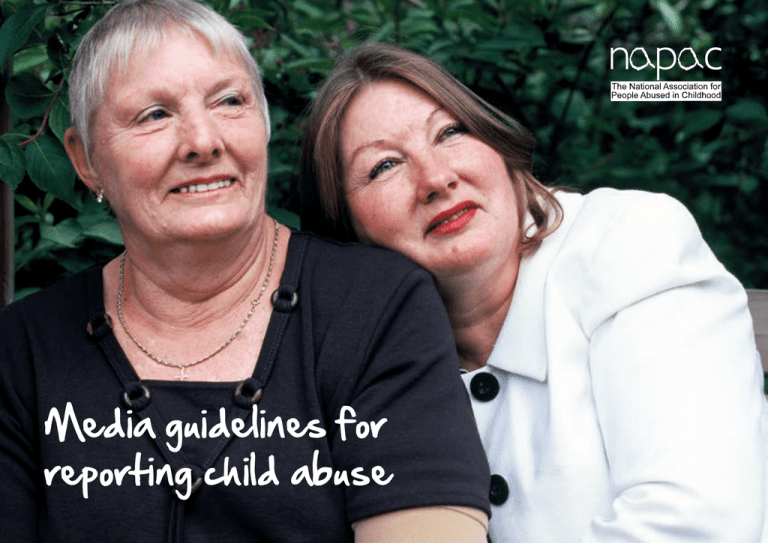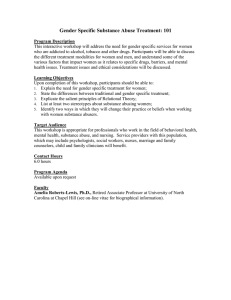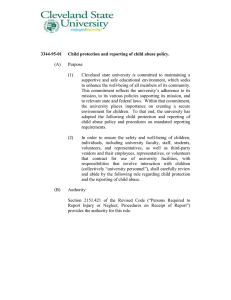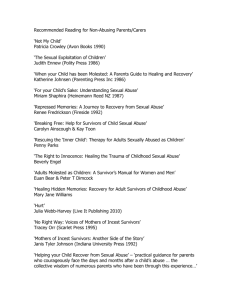
Media guidelines for
reporting child abuse
NAPAC Media guidelines for reporting child abuse
About NAPAC
• We train professionals who have frequent
NAPAC is the only
national organisation
offering support to
adult survivors of all
types of childhood
abuse, including
sexual, physical and
emotional abuse and
neglect.
• We run a free national support line for adult
survivors of child abuse
• We run support groups for survivors.
contact with survivors of child abuse in the
course of their work, such as police, the
prison service, housing officers, mental health
professionals and addictions workers.
• We advocate on behalf of survivors in the
media and elsewhere.
Media contact
Tel 020 7614 1814 media@napac.org.uk
PLEASE INCLUDE DETAILS OF SUPPORT AT
THE END OF YOUR PROGRAMME
Support Line
NAPAC’s Free telephone support line for adult survivors
of child abuse, Support Line 0808 801 0331
napac.org.uk
If you come across information which indicates that
current children are at risk of harm, seek advice from
local Children’s Services or the police.
If in doubt, report.
NAPAC Media guidelines for reporting child abuse
Why read these guidelines?
Good reporting can:
• Improve understanding about how child
abuse happens
• Reduce the stigma facing survivors of child abuse
• Assist police investigations
• Bring about discussions which will help to make
society safer for children today and in the future.
Whether you are a news reporter or write storylines for soaps, we hope this will make you more
aware of how media coverage may affect survivors.
Media coverage often focuses on celebrities or abuse in institutional settings, but the majority of
people are abused by a relative or somebody known to them.
NAPAC Media guidelines for reporting child abuse
Language
Avoid using
Instead try
Why?
‘victims’
‘survivors’
Many adults who were abused as children prefer to be known as ‘survivors’ rather than ‘victims’ in recognition that
they have survived what they have been through, and that they are not permanently stuck in that place of abuse as
a ‘victim’.
Survivors are a diverse group and so are opinions on this. Some prefer ‘thriver’ or ‘abusee’. NAPAC recognises that
in a legal context ‘victim’ is the word that has to be used, given that this is the terminology that exists in legislation.
'historic' or ‘historical’
‘non recent child
abuse’ or state
the decade in
which the abuse
happened.
Rapes are not referred to as historical, nor are child murders or even bank robberies that happened years ago.
Survivors may be living with the physical and mental consequences of abuse every day. There is nothing historic
about it for them.
‘child porn’, ‘kiddie porn’
or ‘child pornography’
‘child abuse
images’ or
‘indecent images
of children’
‘Child pornography’ makes a comparison with adult sexual imagery and almost normalises it. This only serves to
diminish what is a gross sexual violation of children – all child abuse images are crime scenes. Children by definition
cannot consent to their own abuse
‘affair’ or ‘fling’
‘child sexual
exploitation’
A child who is in a sexual relationship with an adult is being exploited and there is likely to have been grooming,
coercion or deception involved.
‘rent boy’ or ‘child
prostitute’
‘sexually exploited
child’
These outdated terms stigmatise and blame children who have been exploited by adults for profit.
‘Child abuse’ is a broad term. When adults are violently raped or tortured, it is described as serious crime. If you are referring to child rape, call it rape rather than abuse.
Refer to sexual assaults and sexual crimes. Pre-watershed shows may have to avoid such specifics, because of younger viewers.
Not all abuse is sexual or physical. Emotional abuse and witnessing horrific domestic abuse in childhood can have terrible impacts into adulthood.
NAPAC Media guidelines for reporting child abuse
Working with case studies
Do’s and don’ts
Case studies bring a
story to life. Although
there are some
common themes in
survivors’ experiences
and responses, each
case is individual,
so please do not
generalise or make
assumptions about
the impact of child
abuse on an individual
survivor.
1. Vulnerability and anonymity
• Don’t try to persuade someone to waive their right to
anonymity, particularly ahead of a court case.
• If you agree to protect someone’s identity, ensure that
the disguise is completely effective.
• Think about all possible risks to a survivor whose
account may become exposed to the public.
• If someone chooses to be identified, they may want a
lawyer to be present to protect their rights to privacy.
Make sure they have psychological support, too.
2. Avoid excessive detail
• When reporting on court cases, avoid publishing
excessive detail about the abuse, as this can add to the
distress of the victim, who may be in a vulnerable state.
• Survivors who are going through the legal process are
entitled to receive psychological support.
• Excessive detail may upset other survivors and can
trigger flashbacks for those with Post Traumatic Stress
Disorder. It can also be stimulating for offenders.
NAPAC Media guidelines for reporting child abuse
Working with case studies
Do’s and don’ts (continued)
3. Contaminating evidence
4. Do not compromise legal proceedings
• Locations, methods of offending, descriptions
• Child abusers may be serial offenders, so naming
or personal details may enable friends, family,
communities and perpetrators to identify individuals.
• Sharing too much information can also undermine
a potential prosecution, by contaminating evidence.
• If there is an ongoing police investigation, the
person should seek advice from the officer in
charge of the case.
an accused person in the media can help bring
perpetrators to justice by enabling other witnesses
to come forward.
• Their evidence might be an account of what
happened to them or corroboration of another
survivor’s account.
• Take care not to make assumptions of guilt,
sensationalise reporting of allegations or interfere
with the legal process.
• Do not offer a survivor or whistle-blower rewards
which could be interpreted as coaching or
influencing the accuracy and authenticity of
the evidence.
• Be mindful of future legal proceedings and the
responsibility to protect current child victims.
NAPAC Media guidelines for reporting child abuse
Working with case studies
Do’s and don’ts (continued)
5. Don’t ask leading questions
6. Accuracy
• Let the survivor speak about their experience in
• Inaccurate or manipulative reporting may lead to
their own words. Ask open questions. Do not ask
leading questions, make assumptions
or suggest answers.
•
hroughout an interview you should quietly
T
acknowledge the survivor’s feelings and emotional
responses. For example, “I can see that this is very
difficult for you to talk about, but it would help me to
understand a bit more about what happened if you
explained if anyone else was present at the time”.
•C
hild sexual abuse at its core does not make
sense, so how a survivor feels about it may
be complex.
survivors being portrayed in the media as unreliable.
• Malicious or false allegations are extremely rare and
no more likely with child abuse than for any other
type of crime whether evidence is presented by
children or by adult survivors.
• Take care not to make assumptions of guilt,
sensationalise reporting of allegations or interfere
with the legal process.
• Sometimes defence lawyers and media use
‘false memory’ and other theories as a way of
dismissing genuine accounts. This adds to the fear
of speaking out for some survivors and reaffirms a
belief that there is nobody out there they can trust.





